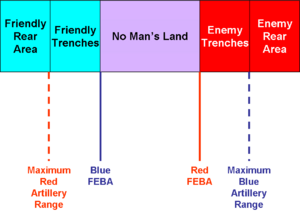Forward edge of the battle area: Difference between revisions
Jump to navigation
Jump to search
imported>Howard C. Berkowitz No edit summary |
Pat Palmer (talk | contribs) (PropDel; self explanatory and obvious, no need for a definition or article) |
||
| (4 intermediate revisions by 3 users not shown) | |||
| Line 1: | Line 1: | ||
{{PropDel}}<br><br> | |||
{{subpages}} | |||
[[Image:WWI-FEBA.png|thumb|left|300 px|FEBA of both sides]] | |||
The '''forward edge of the battle area (FEBA)''' is a military term referring to the generally contiguous line of troops, or sensor and weapon coverage, closest to the enemy. <blockquote>"[the] foremost limits of a series of areas in which ground combat units are deployed, excluding the areas in which the covering or screening forces are operating, designated to coordinate fire support, the positioning of forces, or the maneuver of units."<ref name=JP1-02>{{citation | The '''forward edge of the battle area (FEBA)''' is a military term referring to the generally contiguous line of troops, or sensor and weapon coverage, closest to the enemy. <blockquote>"[the] foremost limits of a series of areas in which ground combat units are deployed, excluding the areas in which the covering or screening forces are operating, designated to coordinate fire support, the positioning of forces, or the maneuver of units."<ref name=JP1-02>{{citation | ||
| last = US Department of Defense | | last = US Department of Defense | ||
| Line 6: | Line 9: | ||
| url = http://www.dtic.mil/doctrine/jel/new_pubs/jp1_02.pdf | | url = http://www.dtic.mil/doctrine/jel/new_pubs/jp1_02.pdf | ||
| accessdate = 2007-10-01}} </ref> </blockquote> | | accessdate = 2007-10-01}} </ref> </blockquote> | ||
It is not quite "no man's land," as friendly scouts and patrols will routinely venture beyond it, up to the [[forward line of troops]]. | It is not quite "no man's land," as friendly scouts and patrols will routinely venture beyond it, up to the [[forward line of troops]]. | ||
In modern warfare, the FEBA may have three dimensions: an aircraft above a given altitude, inside the ground FEBA, may be considered hostile. | In modern warfare, the FEBA may have three dimensions: an aircraft above a given altitude, inside the ground FEBA, may be considered hostile. The [[air defense artillery#ADAM cell|ADAM cell]] in U.S. Brigade Combat Team headquarters is a new organization responsible for [[deconfliction|deconflicting]] the airspace over the FEBA. | ||
==References== | ==References== | ||
{{reflist}} | {{reflist}}[[Category:Suggestion Bot Tag]] | ||
Latest revision as of 10:45, 24 September 2024
| This article may be deleted soon. | ||
|---|---|---|
It is not quite "no man's land," as friendly scouts and patrols will routinely venture beyond it, up to the forward line of troops. In modern warfare, the FEBA may have three dimensions: an aircraft above a given altitude, inside the ground FEBA, may be considered hostile. The ADAM cell in U.S. Brigade Combat Team headquarters is a new organization responsible for deconflicting the airspace over the FEBA. References
|
||
